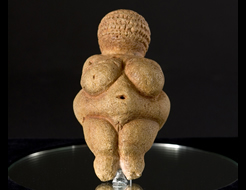|
||||||||||||||||||||||||||||||||
|
|
Museum of: Wien | |||||||||||||||||||||||||||||||
| Name of the artefact: Venus from Willendorf | ||||||||||||||||||||||||||||||||
|
The figurine was found beneth layer 9 of site
Willendorf II, not far from a big fire place together with Gravettian
stone tools. The lack of face feet and th tiny arms on the one hand and
the focus on primary and secondary sex characteristics is typical for the
Gravettian female statuettes. The Gravettian statuettes follow a certain
scheme often interpreted as a common idea of fertility, motherhood or
protection. Their exact place in the imagination of the ice age hunters
can only be supposed. |
||||||||||||||||||||||||||||||||
|
WHERE IS IT AND MAIN
CHARACTERISTICS |
STATE |
|||||||||||||||||||||||||||||||
|
Department: |
Prehistory |
Preservation: |
Very good | |||||||||||||||||||||||||||||
|
Inventory number: |
44.686 |
Restauration: |
No restored | |||||||||||||||||||||||||||||
|
Name of the artefact: |
Venus from Willendorf |
Completeness: |
Complete | |||||||||||||||||||||||||||||
|
Object type: |
Human figurine |
|||||||||||||||||||||||||||||||
|
Material: |
Oolithic limstone |
|||||||||||||||||||||||||||||||
|
Methof of manufacture: |
Sculptered with stone
tools< |
|||||||||||||||||||||||||||||||
|
Decoration
type: |
No decoration |
|||||||||||||||||||||||||||||||
|
Distinctive mark: |
- |
|||||||||||||||||||||||||||||||
|
DIMENSIONS |
PERIOD OF USE |
|||||||||||||||||||||||||||||||
|
Length (mm): |
11cm |
Epoque: |
Palaeolithic |
|||||||||||||||||||||||||||||
|
Heigth
(mm): |
- |
Culture: |
Gravettian |
|||||||||||||||||||||||||||||
|
Diameter
(mm): |
- |
Period: |
Upper Palaeolithic |
|||||||||||||||||||||||||||||
|
Width (mm): |
- |
Face: |
Willendorf-Kostenki |
|||||||||||||||||||||||||||||
|
Thickness (mm): |
- |
Absolute chronology: |
25000 bc |
|||||||||||||||||||||||||||||
|
Weight
(g): |
- |
|||||||||||||||||||||||||||||||
DISCOVERY |
||||||||||||||||||||||||||||||||
|
Date: |
7. 8. 1908 |
Country: |
Austria |
|||||||||||||||||||||||||||||
|
District: |
Krems |
Town hall affiliation: |
- |
|||||||||||||||||||||||||||||
|
Village: |
Willendorf |
Discovery findspot: |
- |
|||||||||||||||||||||||||||||
|
Condition of discovery: |
Archaeological excavation |
Discovery type: |
Dwelling |
|||||||||||||||||||||||||||||
|
ANALYSES – DETERMINATIONS |
FILLED IN BY |
|||||||||||||||||||||||||||||||
|
Type: |
- |
Name: |
Walpurga Antl |
|||||||||||||||||||||||||||||
|
Laboratory: |
- |
Institution: |
Natural History Museum Vienna |
|||||||||||||||||||||||||||||
|
No./Code: |
- |
Date: |
20/02/2006 |
|||||||||||||||||||||||||||||
|
DEEPENINGS |
||||||||||||||||||||||||||||||||
|
Morphology of the object: |
||||||||||||||||||||||||||||||||
|
The completely preserved statuette is made of oolithic
limestone. It shows a naked women with heavy breasts, stout hips and a
prominent belly. Upon weak shoulders there is a relatively big head
showing a rather complicated hairstyle or a hat. Thighs and lower legs are
very realistic but shortened. The feet and the face are completely missing
and the arms are worked out allusively. On both of her arms are bracelets.
originally the figurine was completely covered with red ochre. |
||||||||||||||||||||||||||||||||
|
Decoration: |
||||||||||||||||||||||||||||||||
|
- |
||||||||||||||||||||||||||||||||
|
Inscription: |
||||||||||||||||||||||||||||||||
|
- |
||||||||||||||||||||||||||||||||
|
Analogies: |
||||||||||||||||||||||||||||||||
|
Comparable figurines can be found in Gravettian context
from France to Russia. The Venus from Willendorf combines some
characteristics of the West European and the East European figurines. The
closest similarities can be found at the statuettes from kostenki and
Gagarino. |
||||||||||||||||||||||||||||||||
|
Interpretation: |
||||||||||||||||||||||||||||||||
|
May be the statuettes should express the idea of
fertility or motherhood, perhaps also protection. Their exact place in the
imagination of ice age hunters can only be supposed. Many of the
statuettes were found near fire places or in pits covered with red ochre -
red ochre being often interpreted as symbol for life. |
||||||||||||||||||||||||||||||||
|
Bibliography: |
||||||||||||||||||||||||||||||||
|
- |
||||||||||||||||||||||||||||||||

